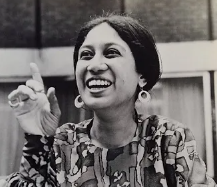 Most people have probably only encountered the work of Norma Tanega through her song “You’re Dead” which is used as the theme song for both the movie of “What we Do in the Shadows” and the ongoing TV series of the same name. The daughter of a Filipino US Navy Band leader and a Panamanian mother, Norma Tanega had one hit song that went to #22 on the US Billboard charts in 1966 called Walkin’ my Cat Named Dog. She has a quick one paragraph description in Rise: A Pop History of Asian America from the Nineties to Now. She died in 2019, but if you think that “You’re Dead” applies to her work, you would be wrong. Despite having only one hit of her own, she was influential in popular music during her day and even some today. To me, Norma Tanega is not only an interesting pop music historical figure, but is a role model of how to create, grow, and impact others positively through her life, whether one is famous and popular or not.
Most people have probably only encountered the work of Norma Tanega through her song “You’re Dead” which is used as the theme song for both the movie of “What we Do in the Shadows” and the ongoing TV series of the same name. The daughter of a Filipino US Navy Band leader and a Panamanian mother, Norma Tanega had one hit song that went to #22 on the US Billboard charts in 1966 called Walkin’ my Cat Named Dog. She has a quick one paragraph description in Rise: A Pop History of Asian America from the Nineties to Now. She died in 2019, but if you think that “You’re Dead” applies to her work, you would be wrong. Despite having only one hit of her own, she was influential in popular music during her day and even some today. To me, Norma Tanega is not only an interesting pop music historical figure, but is a role model of how to create, grow, and impact others positively through her life, whether one is famous and popular or not.
As I mentioned, Norma Tanega’s father was a bandleader in the US Navy, not a surprising service position for a Filipino in the US Navy in the mid 20th century. She shared his musical talents, giving classical piano recitals as a teenager and then learning guitar. She was also interested in painting, and her work was publicly exhibited in Long Beach’s library and municipal art museum while she was still in high school. She later received an MFA from Claremont Graduate School. She was discovered when she performed at her job working as a guidance counselor in upstate New York, and her hit Walkin’ my Cat Named Dog then followed in 1966. Interestingly, the song seemed to have a life of its own, prompting a number of covers ranging from instrumental versions to adaptions in multiple languages. It was even covered much later in 2015 by “They Might Be Giants.”
Walkin’ my Cat Named Dog was very popular in the UK, and when she was touring there to promote her album, she met the singer Dusty Springfield. Dusty Springfield was an influential female singer during the 1960s, part of the British Invasion and known for her blue-eye soul and for popularizing the Motown sound in the UK. They began a working and romantic relationship. Norma moved in with Dusty in England and wrote a number of songs for her and other artists, and Dusty also covered some of Norma’s earlier work. Dusty’s album Dusty in Memphis became included in the Library of Congress National Recording Registry for its significance, and she was included into the Rock and Roll Hall of Fame.
After her relationship with Dusty ended, Norma moved back to the California. She recorded one more album which was nowhere as popular as the second. She then had a second career focused on her painting and teaching. She was an adjunct professor of art at Cal Poly Pomona, and she taught music, art, and English as a Second Language in Claremont Public Schools. Her music continued to evolve, as she began experimenting with ceramic instruments and collaborated on a number of albums (here’s an example of one experimental song done in her 60’s), although none were anywhere as well-known as her first album.
It impresses me that she continued to express herself creatively at a high level through painting and experimental music throughout her life, even though her most popular days had past. I can only hope that my own career would be as high level and impactful for such a long period as hers. Like the members of the band Fanny, she was a queer woman of color who didn’t get a lot of recognition as her peers of her day despite being influential. Her visual art was at a high enough level to get her university teaching positions, and there have been retrospectives on this work in showings in Claremont California and in New York and in a book called Try to Tell a Fish About Water. You can see a quick scan of her work and the book in the video below.
This post only scratches the surface of Norma Tanega’s life. I think that it is great that What We Do in the Shadows seems to have sparked a renewed interest in her work. For more about the aspects of her life, see:
- Her relationship with Dusty Springfield and the challenges of being a lesbian and a person of color in the 1960’s music industry in About a Girl: Norma Tanega and Dusty Springfield.
- The music industry and the meaning of the lyrics of You’re Dead.
- Norma’s offbeat and subtle sense of humor in an interview.








